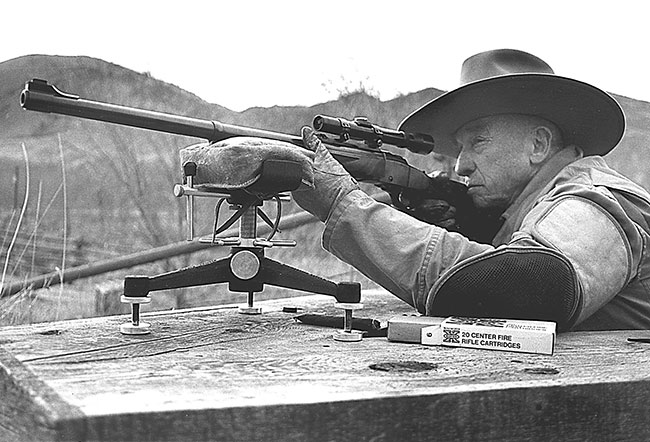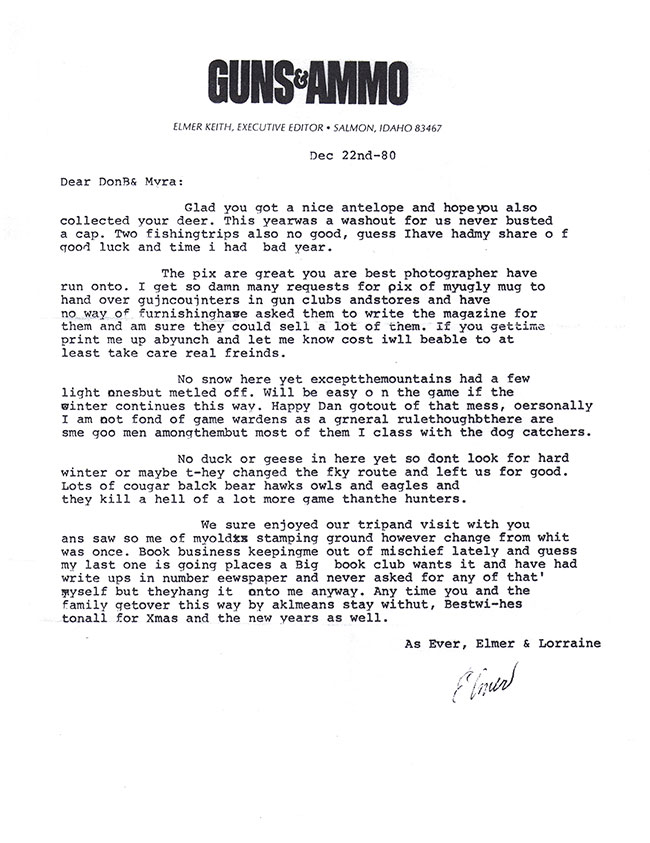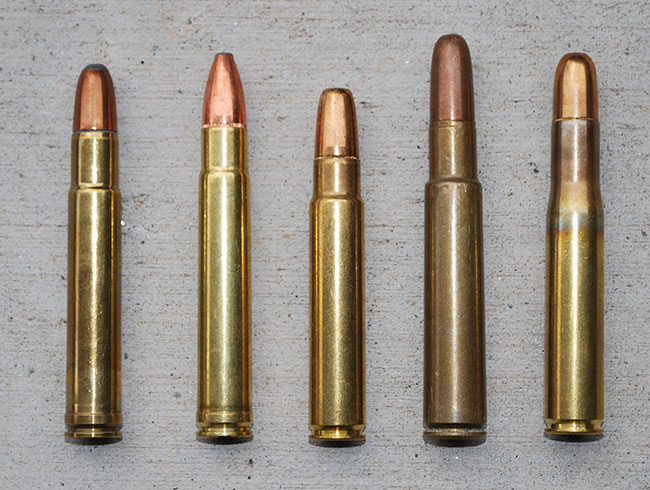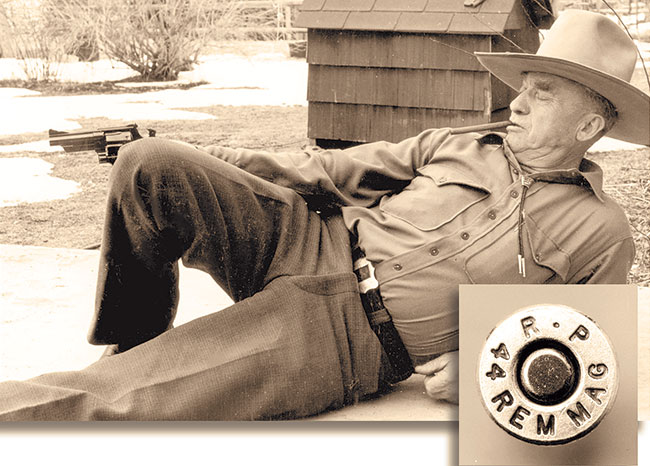The Legend of Elmer Keith
Posted: Tue May 02, 2017 4:15 pm
http://www.gunsandammo.com/remington-hi ... ntent=1956
Remington Timeline: 1956 – Shooting Star: The Legend of Elmer Keith
by G&A Staff | September 9th, 2016
Few writers have cut a more colorful swath through American gun culture than the legendary Elmer Keith. Over the years, many stories about Elmer have been circulated. One that Remington’s Dick Dietz told years ago was about Elmer attending one of the first Remington seminars.
One of the outings at the seminar was to shoot sea ducks that were flying up and down the shoreline (probably along the Chesapeake Bay). As Dick recalled, Elmer was standing a few hundred yards down the beach blasting away with a 10-gauge as the ducks came on. He was wearing a knee-length camo raincoat, but his signature white, 10-gallon hat remained perched atop his head.
Dick noticed that Elmer was not having much luck with the birds and after a while he walked down the beach to speak with him. After exchanging pleasantries, Dick asked: “Elmer, aren’t you afraid the birds will see your white hat and flare?”
Without missing a beat Keith responded, “Why Dick, by the time those birds see this hat, they’re within range!”
That was vintage Keith and few have summed this legendary writer up better than Craig Boddington in this classic article from Guns & Ammo.
The late founder of this magazine, Robert E. “Pete” Petersen, believed in the star system when it came to gunwriters; he always wanted the best in the business writing for his magazines. Over the years, G&A showcased a lot of great gunwriters, but from the early days of the magazine until his death in 1984, Elmer Keith was the brightest star.
This was his long-running column, and although I am not the first writer to take it over since his passing, believe me when I tell you that it wasn’t my idea. It’s sobering to try and fill Elmer’s boots, and in our current multimedia age, I don’t believe that anyone else will ever have the reach and power—or lasting legacy—of guys like Elmer, Jack O’Connor and a handful of others.
This letter is from Elmer to his friend Don Hurd, complete with the run-together words and typos. Editing Elmer wasn’t easy, but the results were worth it.
I don’t lay claim to having known Elmer well. I was the kid editor when I joined Guns & Ammo in 1979, and as such, I was assigned to edit his material. This was no easy job—which was why it was invariably assigned to the new guy. Also, like most writers, Elmer had mixed feelings about editors, and if he came riding down from Idaho to sort things out with his Model 29—as we all feared—well, they could always get another new guy. But I saw him at the shows and the early writers’ events I attended, the stubby guy in the big hat with the big cigar. He was a character, but he was the real deal, and I genuinely believe everything he wrote was true. I don’t think he was capable of telling a lie or even exaggerating.
Take for instance the controversy when he wrote about his 600-yard shot on a mule deer with his .44 Magnum. He was criticized for years, but put it in context. Someone else had wounded the buck, and Elmer was trying to keep it from getting over the next ridge. He was completely honest about walking his shots into the buck, and I’m sure it happened just the way he wrote it.
Aside from how genuinely friendly he was, Elmer’s magic was that he really knew his stuff. He was equally expert with rifle, handgun and shotgun, and during his long career he made significant contributions in all three arenas.
The first time I ever saw Elmer Keith was when the NRA Convention was held in San Diego. I was stationed at Camp Pendleton, so that was probably 1975. Elmer was at one end of the Petersen Publishing booth, Jack O’Connor at the other. Jack could be stand-offish in a crowd and looked like the college professor he once was—a little bit uncomfortable. Elmer, well, he looked like Elmer, and he was genuinely happy to be there and delighted to talk to everyone.
We won’t compare quality of manuscripts. After all, O’Connor had been an English professor and novelist. Elmer was Elmer. By the time I had the, er, pleasure of turning his raw copy into magazine articles, age probably didn’t help much (he was 80 by then). The spelling wasn’t bad at all, but a Keith manuscript was full of run-together words and occasional missing letters—our theory was that his typewriter had some malfunctioning keys. The first task, then, was to try to figure out exactly what he was saying. And woe to the young editor who misunderstood his meaning! But we got on well, mostly from a distance. And, yes, he really did hate Jack O’Connor, although history suggests that O’Connor didn’t reciprocate. That was a time when people still wrote real letters, not emails. I have a few, and in one Elmer wrote that he was “getting on, and I’d best get over the mountain and *&@$!%* on ‘.270 Jack’s’ grave while I still can.”
Designed by the famous O’Neil-Keith-Hopkins team, the .400 OKH (left) preceded the rebirth of the .416s. From left: .400 OKH, .416 Rem. Mag., .416 Ruger, .416 Rigby and .404 Jeffery.
A little while ago Don Hurd of Billings, Mont., sent me some great Elmer Keith memorabilia. He was a friend in Elmer’s later years, and the treasure trove included letters, copies of photos with Elmer and Mrs. Keith (Lorraine) and a cartridge that raised a bit of a mystery. We know that Elmer’s hot handloads in .38 Special, .44 Special and .41 Long Colt resulted in the development of the .357, .44 and .41 Magnum cartridges. We know that the O’Neil-Keith-Hopkins team developed the .333 OKH, essentially the .338-06 with a .333-inch (.333 Jeffery) bullet, and the full-length .375 H&H case sized down to create the .334 OKH, which became the .340 Weatherby. Elmer loved his .33s and deserves credit for the .338 Winchester Magnum. Working with Bob Thomson, he developed the .338-.378 KT (Keith-Thomson), which became the .338-.378 Weatherby Magnum.
But the cartridge Don sent me is the .400 OKH, annotated as being from Elmer’s rifle. Here’s the mystery: Any decent reference that includes wildcat cartridges will give you Elmer’s .33 wildcats, and most mention the .475 OKH, which also went nowhere. Oddly, however, I couldn’t find a single mention of the .400 OKH. I do remember it from Elmer’s writing, and I believe he used it on at least one of his safaris with Bob Petersen in the early 1970s. As we know, he took his elephants with his beloved double rifles (Elmer contributed greatly to keeping the concept of the double alive), but I think I recall a photo of a lion Keith took with his .400 OKH.
The cartridge is a full-length .375 H&H case necked down with some of the body taper removed. I miked the bullet at .411, nominally the same as the .450/.400, but in a bolt action it would yield 2,400 fps with a 400-grain bullet. It is not the only attempt at a true .40-caliber cartridge for a bolt-action rifle. The .400 Whelen on the .30-06 case goes back another generation, but with that case capacity it would have been a bit mild for the largest game. In the 1980s the proprietary .411 KDF achieved some popularity, and Holland & Holland’s relatively new proprietary .400 H&H is quite similar. But Keith’s version is a great-looking cartridge, with plenty of neck and a fairly sharp shoulder. It looks very effective, and I’m sure it is.
In performance it would be essentially identical to the .416 Remington/Rigby/Ruger or .404 Jeffery, so I suppose we have plenty of factory cartridges in this power range. And, the way things developed, there are a lot more bullets in .416-inch and .423-inch bullet diameter than .411. However, looking at the proliferation of .416s, there was clearly a market for a “.40 caliber” in this power range, and Keith developed his version long before the rebirth of the .416.
A fitting legacy: Elmer will forever be associated with the .44 Magnum and S&W’s Model 29.
Elmer will always be remembered as a fan of the big bores. His disdain for what he considered inadequate calibers was legendary. This quote from our November 1961 issue pretty much sums up his feelings in that regard: “I like one-shot kills where possible and prefer to do all my hunting before I shoot.”



